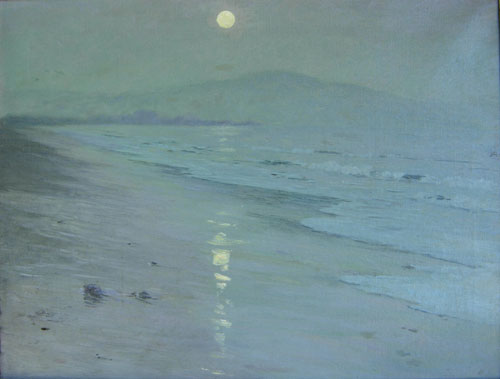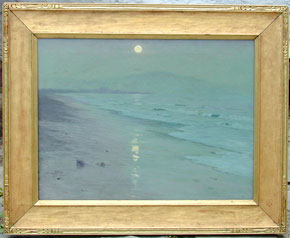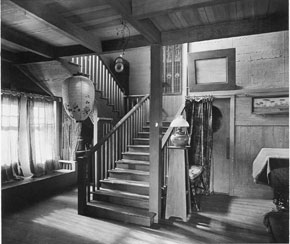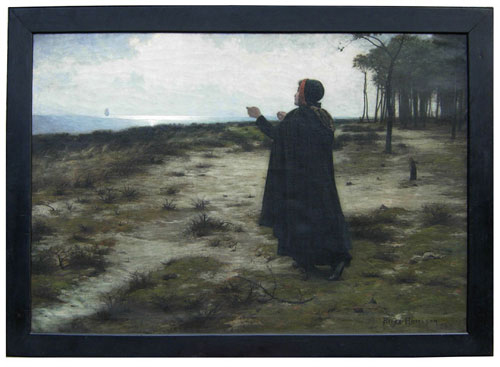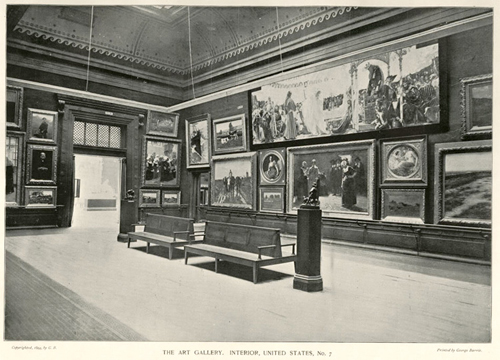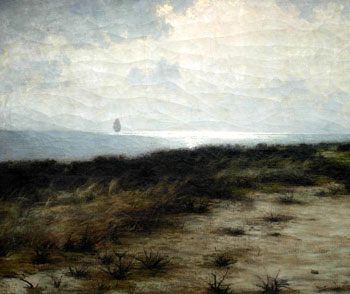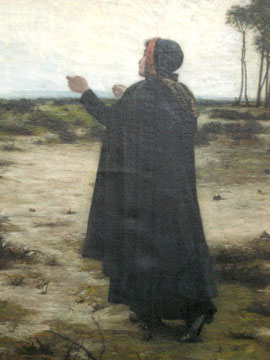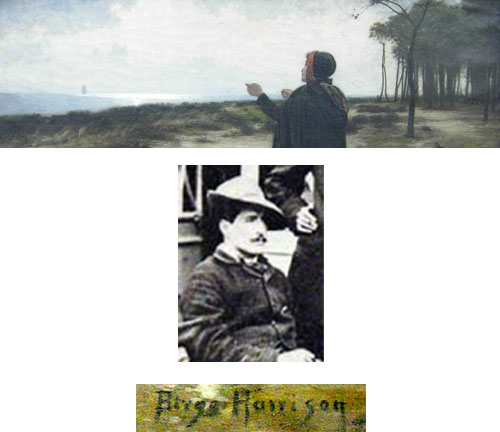|
MOONRISE ON THE SEA “Moonrise on the Sea” is a highly important tonalist painting purchased directly from the artist by Jane Byrd McCall Whitehead in 1896. The painting remained in the Whitehead family home in Woodstock, New York until 1976 when Peter Whitehead died. The painting has never before been offered for sale. We are pleased to be able to offer it now. Lovell Birge Harrison had a studio near Arcady the Montecito home of Jane and her husband Ralph Radcliffe-Whitehead. The mountains in the background of this view of the Pacific may well be the Santa Inez range, also visible from Arcady. Jane’s diaries reveal that she purchased the painting from Harrison as a surprise birthday present for Ralph. Period photographs show the painting hanging in Whitehead’s Arcady study. The Whiteheads founded the Byrdcliffe Arts & Crafts Colony in Woodstock in 1903 and the painting was moved to a prominent position in the stair hall of White Pines. Lovell Birge Harrison (1854-1929) was born in Philadelphia and studied art at the École des Beaux-Arts in Paris. “Moonrise on the Sea” is a paramount example of his most coveted work, which often depicts moody, misty night scenes so popular with artists like James McNeill Whistler, Edward Steichen, Dwight William Tryon, and Arthur Wesley Dow and collectors like Charles Freer at the turn of the last century. The Whiteheads chose Harrison to be the first instructor in painting at Byrdcliffe. Although no known Byrdcliffe furniture decorations are by Harrison’s hand, there is little doubt that the placement of this painting in the most important building at the colony and his teaching had a direct influence on the landscapes made for Byrdcliffe cabinets by Hermann Dudley Murphy, Victor Andersen, and Bolton Brown.
Illustrated: Robert Edwards et al. Life By Design: The Byrdcliffe Arts & Crafts Colony, Wilmington, DE, page 6 for a period photograph of the painting at Arcady. Robert Edwards, “Furniture Designed at the Byrdcliffe Arts and Crafts Colony,” The Magazine Antiques, May 2003, page 109, plate X. Nancy Green et al. Byrdcliffe: An American Arts and Crafts Colony, page 182
“THE RETURN OF THE MAYFLOWER” Lovell Birge Harrison was born in Germantown, Pennsylvania. At age twenty-one after a stint farming grapes and strawberries he began to study art under Thomas Eakins at the Philadelphia Sketch Club. In 1876 he went to Paris where he studied with Charles Carlous-Duran and at the École des Beaux-Arts, which doubtless accounts for the Barbizon influence in his early paintings. The Barbizon painters left the confines of their studios and went out into the countryside to paint peasant life in its natural setting. They inspired Harrison’s life-long interest in plein-air painting. He said he wished to capture the “pearly tones of out-door nature.” After a period of travel, Harrison and his first wife Eleanor, who was also an artist, established a studio in an artists’ colony in Etaples, France, where, according to Andrea Husby, he completed “The Return of the Mayflower” (Husby’s dissertation misquotes the painting’s title as “The Departure of the Mayflower”) sometime between 1886 and 1889. Then the Harrisons moved again, this time to Eleanor’s native Australia.
By the time “The Return of the Mayflower” was exhibited and awarded a medal at the 1893 Chicago World’s Columbian Exposition, the Harrisons had settled in Santa Barbara, California near Arcady, the home of Jane and Ralph Radcliffe-Whitehead. Harrison’s paintings of the Pacific coast near their home show how he had aligned his love of nature’s “pearly tones” so evident in “The Return of the Mayflower” with the ideas of American Tonalist painters. When the Whiteheads established their Arts & Crafts colony Byrdcliffe at Woodstock, New York, they asked Harrison to head the painting department. Despite much previous experience in art colonies, Harrison did not thrive in the Byrdcliffe hothouse so he left in 1906 to head the summer school of the Art Students League of New York, which had relocated to Woodstock. Birge Harrison continued to teach landscape painting and to paint the Woodstock countryside--where the winter snows looked particularly pearly--for the rest of his life. Harrison exhibited “The Return of the Mayflower” as a seminal example of his work numerous times. His artist brother Alexander organized an exhibition of the brothers’ paintings that opened at The Albright Art Gallery in Buffalo, New York (now Albright-Knox Art Gallery) in 1913. Return of the Mayflower was the only example of Birge Harrison’s figurative work in that exhibition, which traveled to major American museums for two years gathering critical acclaim for both brothers.
In retrospect it is easy to find elements in “The Return of the Mayflower” that would later make Harrison famous. The nacreous light in the sky and on the sea, the misty haze out of which the Mayflower emerges, and the strong diagonal of the shore are all devices that dominate Harrison’s Tonalist works. But some art historians think the subject rather than the method is the significant part of this painting. Certainly those who saw it at the Chicago fair understood it in the context of the Colonial Revival, which entranced many including Harrison when it first blossomed at the 1876 Centennial Exposition in Philadelphia.
|
|||||||||
